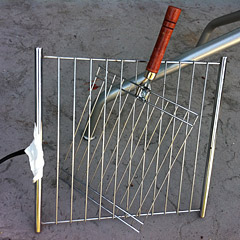Posted: May 16th, 2013 | Author: Nathan | Filed under: found sound objects, sound design
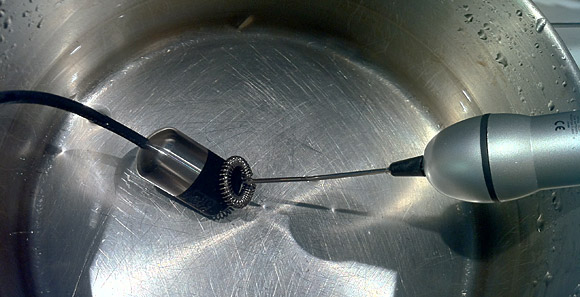
This thing was given to me as a Christmas gift. I immediately wanted to not froth milk with it, but to record it. With a hydrophone.
It was initially disappointing…until I put it into a metal pan and realized that its interaction with the pan, not the water, was far more interesting. The hydrophone was still in the water, but the frother was used in the water, inside the pan, and outside the pan as well, at varying speeds.
[soundcloud url=”http://api.soundcloud.com/tracks/73914784″ params=”auto_play=false&show_artwork=false&color=ee0000″ width=”100%” height=”166″ iframe=”true” /]
[Aquarian Audio H2a-XLR hydrophone into Sound Devices 702 recorder]
Tags: hydrophone, metal, sound design, sound effects | No Comments »
Posted: October 31st, 2012 | Author: Nathan | Filed under: field recording, sound design
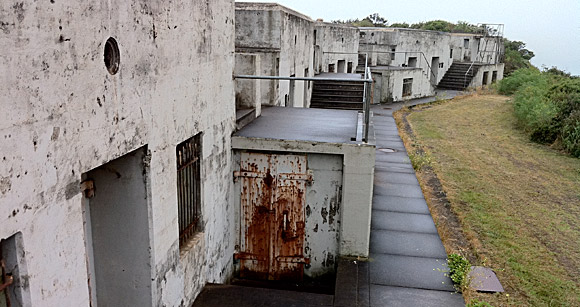
Battery Yates, Fort Baker, Sausalito, California.
Over a year ago, I posted some scraping metal sounds from the steel doors of Fort Baker’s Battery Yates, right at the Golden Gate of the San Francisco Bay. I recently unearthed some metal hits from that same session: They’re heavy, resonant, and the concrete rooms behind them certainly lent the sound some nice air in the low end. (Read the previous installment if you want to learn more about this location and how it was recorded.)
And, since today is Halloween, the original sounds are presented in both their original form and pitched down by an octave for extra heaviness and spookcreeptacularness.
Enjoy the clanky, boomy fun…and happy Halloween!
[soundcloud url=”http://api.soundcloud.com/tracks/65535342″ params=”auto_play=false&show_artwork=false&color=ee0000″ width=”100%” height=”166″ iframe=”true” /]
[MKH 50 microphone into Sound Devices 702]
Tags: creepy, field recording, industrial, metal, resonance, San Francisco, sound effects | No Comments »
Posted: October 13th, 2011 | Author: Nathan | Filed under: found sound objects, sound design
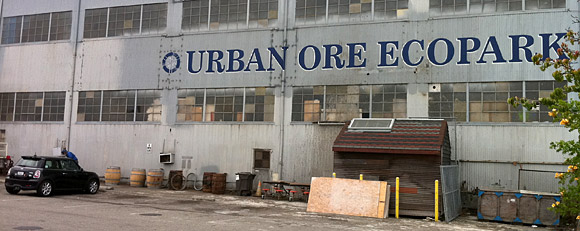
My mecca on a foggy morning: Urban Ore!
I went to the granddaddy of thrift stores recently, so much so that it’s more of a glorified junk store…but oh, what glorious junk. I’m talking about Urban Ore in Berkeley, California. Sometimes I’m self-conscious shopping for things by ear, picking up random things and just listening to them, but at Urban Ore – heck, Berkeley in general – I can ear-shop in peace.
I was in a metallic mood, so I filled a bag with things that squeak, resonate, creak, clank, and sproing. Based on the dronetastic results of striking wire shelving last year, I picked up a few thin-wire metal grills that had sonic promise, among other things that will surely find their way to this blog later this fall and winter.
For the grills, I decided to trot out my much-neglected piezo contact microphones. The resonant notes were so subtle that it seemed like the best way to capture the sound at a reasonable volume. I plucked them, struck them, and played them with a cello bow. The magic happened, though, when I realized one was easily played with a bow and the other was not, so I stuck the bowable one inside of the other, and played away, causing both of them to resonate when played appropriately.
The results were like ultra-low-fi bastardizations of stringed instruments played in horror movies, and I just loved the character. The rawness of hearing the actual hairs of the bow on the metal, in my opinion, lends to the eerie charm.
[soundcloud url=”http://api.soundcloud.com/tracks/25407627″ params=”show_comments=true&auto_play=false&color=ee0000″ width=”100%” height=”81″ ]
[Contact microphone into Sound Devices 702 recorder]
Tags: creepy, digital audio, eerie, found object, groaning, horror, metal, resonance, sound design, sound effects | No Comments »
Posted: August 2nd, 2011 | Author: Nathan | Filed under: field recording, sound design
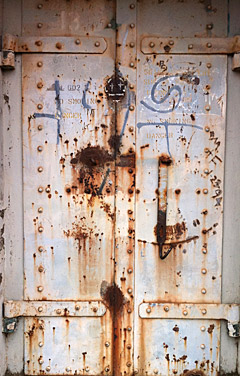
Rusty? Heavy? Covered in graffiti? You KNOW it will sound good.
Many people are unaware that the San Francisco Bay Area was once thoroughly fortified against attacks from the sea. Remnants of this past dot the entrance to the Golden Gate, in the form of bunkers that once housed gun emplacements.
One such installation was Battery Yates at Fort Baker. Located at the best vantage point for southward-facing photos of the Golden Gate Bridge, Battery Yates was meant for nothing other than picking off minesweepers that might try to get through the minefields inside the ‘Gate in wartime…minesweepers, of course, that would never come.
Battery Yates was active from 1905 through 1946. Now, only the U.S. Coast Guard maintains a station at Fort Baker, primarily for saving the lives of boaters and wind/kitesurfers. Now Battery Yates is a tourist attraction, is fun to scramble on and around…and, in swords to ploughshares style, is also a great source for cool sounds!
Each of the gun emplacements has four lockers, each sealed with a massive steel door. Some doors have outer latches that have been left to swing freely in favor of just welding the doors shut. These latches, rusted by more than 60 years of salty mist, are quite expressive when swung, manipulated, and otherwise mishandled. The perfectly square concrete rooms behind these doors caused them to have a lot of low end and resonance.
I decided to try my luck with recording some groaning metal effects on these doors, despite the fact that:
- I only had some time before work one weekday, which meant that…
- I could only record during rush hour, made worse by the fact that…
- The Golden Gate Bridge is only 1/8 of a mile away, plainly visible from the recording site.
All this meant lots of background traffic noise. I mitigated these risks by using a hypercardioid microphone for off-axis rejection of sound (a shotgun would have been a better choice in terms of pattern, but I just loved the sound of my MKH-50 too much to not use it), careful placement of the mic relative to the bridge (making sure that either the mic element faced away from the bridge or a thick concrete wall blocked line of sight), and the judicious use of the Denoiser plugin from iZotope RX. And, for effects like these, the small-condenser-mic proximity effect only helps!
The result came out pretty well, all things considered…although the editing in today’s post is pretty sloppy, so apologies for that. Everything was recorded at 24-bit, 192-kHz, as best befits complex groaning metal sounds, since pitching this stuff down can yield pure sound-design gold. I recorded even more massive metal hits from this session, which may be a topic for a separate post… (And until then, you can hear yet more heavy metal hits/impacts here, here, and here.)
[soundcloud url=”http://api.soundcloud.com/tracks/20003445″ params=”show_comments=true&auto_play=false&color=ee0000″ width=”100%” height=”81″ ]
[MKH 50 microphone into Sound Devices 702]
Tags: field recording, groaning, industrial, metal, noise reduction, resonance, San Francisco, sound design, sound effects, urban | 4 Comments »
Posted: May 12th, 2011 | Author: Nathan | Filed under: field recording, found sound objects, sound design
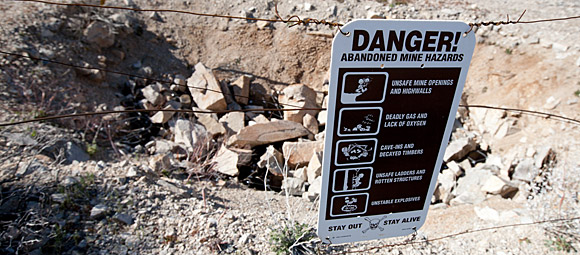
Eton Mine, Lucky Boy Trail, Joshua Tree National Park, California, USA.
[One in a series of posts from my spring 2011 trip to the southern California desert.]
Joshua Tree National Park is beautiful, but much of its history (prior to being designated a National Park) has scarred and pockmarked its landscape. In the Gold Rush, the Joshua Tree hinterlands held some of the most productive mines in California until well into the 1900’s. These mines were big, sprawling, and deep. To my knowledge, no Balrogs were released as a result. But that would explain a lot about Golden State politics.
We hiked on some lesser-traveled trails and found an acre of land with no fewer than five vertical holes in the ground: Mine shafts. They were all wired off and had metal grates over them. One in particular, the Eton Mine on the Lucky Boy trail, had warning signs on the wire fence surrounding it.
It was quite windy that day, and I just knew I had to get the creaking, squeaking sounds of this battered sign on the rusty wire. It took me a surprisingly long time to figure out how to protect my handheld recorder from the wind, but ultimately I decided to use my body as a shield and then stick it under my microfleece hoody. (I had the OEM fuzzy windscreen on it, which is one of the most useless strips of fabric I’ve ever seen, er, heard.) I just hoped that my body protected it from the 25+ mph wind gusts and that the fabric wouldn’t dampen the high frequencies too badly…and because of the sound, I had high-frequency content to burn.
With some judicious noise reduction in post – subtle, as always, gives the best result – it didn’t come out too shabby, considering the horrible recording conditions and super-no-budget wind blocking techniques!
[soundcloud url=”http://api.soundcloud.com/tracks/15163504″ params=”show_comments=true&auto_play=false&color=ee0000″ width=”100%” height=”81″ ]
[Sony PCM-D50 recorder, capsules at 120°]
Tags: creepy, desert, digital audio, eerie, field recording, found object, industrial, joshua tree, metal, resonance, sound design, sound effects, travel | 1 Comment »
Posted: January 20th, 2011 | Author: Nathan | Filed under: found sound objects, sound design

Mr. Heater, the oddest and loudest camping stove ever.
One of the guys at work loves camping gadgets (as do I), and he shared a video of his odd little Mr. Heater camp stove making some weird unholy racket. Naturally, I asked to borrow it and did some recording sessions with it over the holidays.
A metal reflector lets the unit be used as either a heater or a camp stove. This ring of steel doesn’t make much sound when it’s running (all you hear is the hiss of gas emission, much like this recording), but it sure resonates when the stove fires up, starting as one tone and diverging into two separate tones, creating a harmony. Very effective or driving away bears, or as a means for summoning the dead.
The only processing applied to this sound is some noise reduction to minimize the gas regulator’s hiss, to pull the resonance forward. Recorded at 192kHz, a clip like this is ripe for pitch shifting for even scarier tones! (Mic placement was tricky; placing the mics right in front would melt them instantly.)
[soundcloud url=”http://api.soundcloud.com/tracks/9154382″ params=”show_comments=true&auto_play=false&color=ee0000″ width=”100%” height=”81″ ]
[Sennheiser MKH 50/30 pair, rigged for mid-side stereo, into a Sound Devices 702 recorder]
Tags: field recording, industrial, metal, resonance, sci-fi, sound design, sound effects | 5 Comments »
Posted: December 20th, 2010 | Author: Nathan | Filed under: found sound objects, sound design
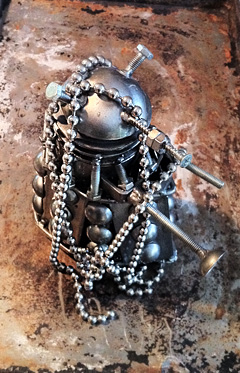
Exterminate! Exterminate!
In North America, the end of the Western calendar year brings Thanksgiving, Hanukkah, Kwanza, Christmas…lots of holidays, most of which revolve around eating. In our household, that means one thing above all else: PIE SEASON.
My wife loves making pies and tarts, and one of the baker’s secret weapons for such endeavors are pie weights. They’re simply large, heavy versions of the more common metal-ball-style keychain. Ours is about four feet in length.
While washing dishes after a piemaking bonanza, I noticed the sound it made as I dragged it over the lip of our stainless steel sink. Finally, on a rainy winter day, I decided to do some recording and processing.
I grabbed three things for this session: The pie weights, a really beat-up baking sheet, and a small model of a Dalek made from spare parts (a gift from a dear friend). I simply moved the pie weights across each of these objects in different ways. Hot metal-on-metal action!
The balls on the pie weights made a great ratcheting sound that instantly made me think of a castle portcullis being raised and lowered, or a ship’s winch retracting an anchor. Of course, the size of these weights made pretty bright sounds, but that’s what pitch shifting is for…
So, today’s sound is a mix of these sounds, some raw, and some pitched down significantly. I didn’t do anything besides pitch shifting and EQ, just to show how flexible these high-frequency, detailed sounds can be when recorded at 192kHz. These sounds were recorded with a large-diaphragm condenser mic, because I found that proximity effect from close-miking with a small-diaphragm condenser produced too much bass to provide the balanced, bright sounds that I was going after.
[soundcloud url=”http://api.soundcloud.com/tracks/8225412″ params=”show_comments=true&auto_play=false&color=ff7700″ width=”100%” height=”81″ ]
[Røde NT1a microphone into Sound Devices 702 recorder]
Tags: dalek, digital audio, field recording, industrial, machine, metal, pie, sound design, sound effects | 5 Comments »
Posted: October 28th, 2010 | Author: Nathan | Filed under: field recording, found sound objects

Beer, toiletries, ice chest, field recorders. Yep, that's a well-stocked camping trip!
The metal bearproof food locker is a common sight in the developed campgrounds of the Sierra Nevada mountains. They’re infamously noisy to open, close, and move things around in, and are usually the first sounds you hear in the morning. They do their job, though…provided you have them closed. I once had a close encounter with a bear whose head was stuck right into my slightly open bear locker (in my defense, it was in the midst of dinner preparation), but that’s another story for another blog.
I finally decided to record one on a trip this summer. It was a kayaking trip, so I had both my Zoom H2 [yeah, this is an older sound] and a hydrophone, so I decided to use both: The Zoom would get the stereo effects and the hydrophone would pick up the raw vibrations. I placed the H2 horizontally centered in the locker, and placed the hydrophone on the single shelf inside. Holy resonance, Batman!
Today’s sound is a collection of hits from this outdoors session, made with hands, metal objects, and a rubber mallet, first at normal pitch and then an octave lower. It wound up mixing rather well with my collection of shovel-in-wheelbarrow sounds from a while back. Get those subwoofers ready for the second half…
[soundcloud url=”http://api.soundcloud.com/tracks/6510828″ params=”show_comments=true&auto_play=false&color=ee0000″ width=”100%” height=”81″ ]
[Zoom H2 (120° capsule spread), Aquarian Audio H2a-XLR hydrophone into Sound Devices 702 recorder]
Tags: digital audio, field recording, found object, industrial, metal, microphone, percussion, sound design, sound effects | 8 Comments »
Posted: July 22nd, 2010 | Author: Nathan | Filed under: field recording, found sound objects
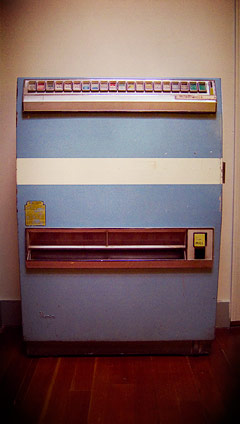
Mmm, so many tasty, carcinogenic choices.
Like over 100 other field recordists, I signed up for Tim Prebble’s crowdsourced special effects library of doors from around the world on his boutique effects label, Hiss and a Roar.
Unfortunately, due to extenuating circumstances, I had to bow out of the project, and a number of other side-projects. (Saying “no” is a powerful tool to help rein in your life from your own over-committal. Just do it early enough.)
However, one of the more interesting doors I did manage to record was the hinged front panel of an all-metal, 1970’s-era cigarette vending machine. This thing lives in my office, inherited from previous tenants. It’s too big to get rid of, and too odd and ironic to let go of, since none of us smoke. This object has been heard here before.
In honor of the awesome work everyone has done on this upcoming release, today’s sound is a fragment of my own aborted contribution, in the hopes that everyone will support Hiss and a Roar and pick up the collection when it’s released.
[soundcloud url=”http://soundcloud.com/noisejockey/cigmachinedoorslams” params=”show_comments=true&auto_play=false&color=dd0000″ width=”100%” height=”81″ ]
[Sennheiser MKH 50/30 mid-side stereo pair with into Sound Devices 702 recorder]
Tags: creak, digital audio, door, field recording, found object, machine, metal, sound design, sound effects | 8 Comments »
Posted: July 14th, 2010 | Author: Nathan | Filed under: field recording, found sound objects, sound design
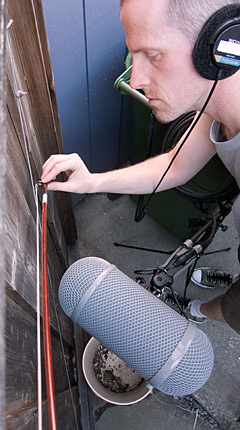
Noise Jockey: Taking the "E" out of "e-bow."
Almost exactly one year ago, I played a steel cable on a gate with an eBow , recorded with contact microphones. I decided to give it a go with a regular bow when I realized that this gate was basically a one-stringed guitar.
, recorded with contact microphones. I decided to give it a go with a regular bow when I realized that this gate was basically a one-stringed guitar.
Think about it: Wound metal string under tension, wooden resonator. That’s all a guitar really is. What a wooden gate lacks is thickness, like a guitar, but at more than a meter in width and height, that’s a broad-enough surface to send air molecules running for cover.
I had to rosin the hell out of the bow to make it tacky enough to grip this oversized “string.” I found that also spreading rosin on the wrapped steel cable was helpful. I tuned the cable, as much as one can, by adjusting a turnbuckle.
I recorded in mid-side stereo. Today’s sample features is comprised of one mono track totally dry, one mono track run through Michael Norris’ Spectral Blurring effect, one mono track pitch-shifted down by 1.5 octaves, and the one stereo track pitch-shifted down by three octaves. Recording at 192Hz helps for such tomfoolery.
I apologize to my neighbhors for the unholy racket that I’m sure they thought was a demonic violin 101 class.
[soundcloud url=”http://soundcloud.com/noisejockey/satans-violin-lesson” params=”show_comments=true&auto_play=false&color=dd0000″ width=”100%” height=”81″ ][Sennheiser MKH 50 and MKH 30 recorded as mid-side stereo into Sound Devices 702 recorder]
Tags: digital audio, drone, experimental, field recording, found object, industrial, metal, mid side, sennheiser, sound design, sound effects, violin bow | 5 Comments »



